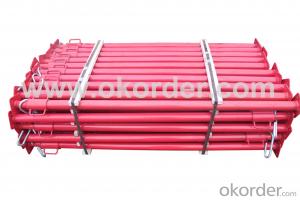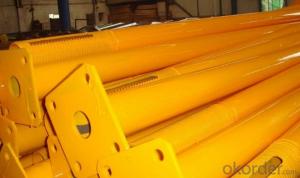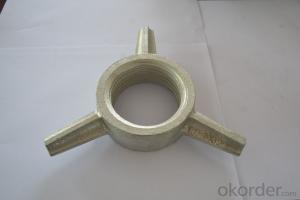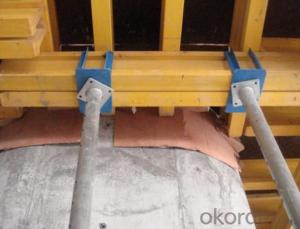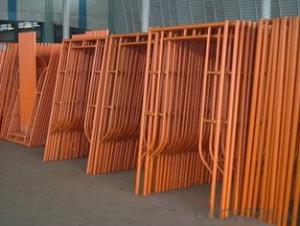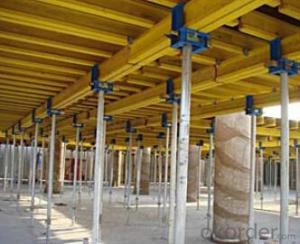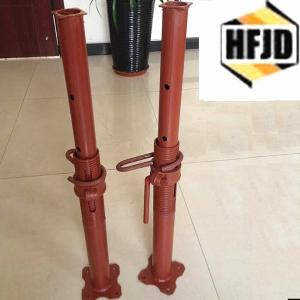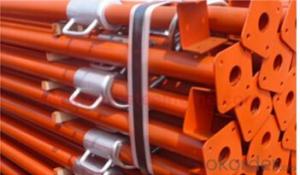1-8m Adjustable Scaffolding Steel Props/ Shoring Props
- Loading Port:
- Tianjin
- Payment Terms:
- TT OR LC
- Min Order Qty:
- 10000 PCS
- Supply Capability:
- 10000 PCS/month
OKorder Service Pledge
OKorder Financial Service
You Might Also Like
Quick Details
| Model Number: | 1-8m | ||||
| Surface treatment: | painted, powder coated, galvanized | Common height: | 1-8m (3.2-27 feet) | Outer tube diameter: | 40-90mm(1 1/4"-3'') |
| Inner tube diameter: | 30-90mm (1"-3'') | Wall thickness of tube: | 1.6-4mm (0.06''-0.16'') | Pin: | straight / hooked |
| Top plate /Top head: | flat(square/flower shaped), U shaped as clients' requirements | Base plate/Base head: | flat (square/flower shaped) as clients' requirements | Colour: | blue, orange, black, yellow, red, sliver as clients' requirements |
| More contacts: | Skype: watson2013W |
Packaging & Delivery
| Packaging Detail: | standard package, or as clients' requirements |
| Delivery Detail: | generally 1-3 weeks based on the quantity and specification |
Specifications
1. full types
2. large supply
3. ISO quality certificate
4. all kinds of surface treatment
5. accept customized order
WHY YOU CHOOSE US:
1. We have many years of experiences.
2. We have many certificates which can assure the quality of our products.
3. We have many projects in the shipyard companies of south of China.
4. We have strong engineering team that can give best solution for your projects.
5. We can take you to visit our factory.
6.Good after-sale service offered,please get back if you have any question.
Our Service:
1.Your inquiry related to our product & price will be replied within 24hours.
2.Well-trained &experienced staff are to answer all your inquiries professional in English of
course.
3.Working time: 8:00am - 5:30pm, Monday to Friday. OEM is highly welcomed.
4.We have strong R&D team here to help.
5.Your business relationship with us will be confidential to any third party.
6. Good after-sale service offered, please get back if you got question.
- Q:Are steel props adjustable in both inclination and declination?
- No, steel props are not adjustable in both inclination and declination.
- Q:Are steel props resistant to impact or vibration?
- Both impact and vibration are generally resisted by steel props. Due to its strength and durability, steel is able to endure substantial impact forces without any harm. Furthermore, steel possesses a high natural frequency, enabling it to efficiently absorb and disperse vibrations. Consequently, steel props are deemed highly suitable for situations where resistance to impact and vibration is crucial, such as in construction, scaffolding, and temporary support structures. Nevertheless, it is important to acknowledge that the precise impact and vibration resistance of steel props may differ based on their individual design, quality, and installation.
- Q:Which is not included in the price
- The installation of steel support at both ends of the height must be controlled at 2 cm or less, supporting deflection is not greater than the length of the L/400 support, the horizontal axis deviation is less than 5 cm.
- Q:Can steel props be used for temporary support in oil and gas projects?
- Yes, steel props can be used for temporary support in oil and gas projects. Steel props are commonly used to provide temporary structural support during construction, maintenance, and repair activities in various industries, including the oil and gas sector. These props are typically adjustable in height and can be easily installed and removed, making them ideal for temporary support applications. In oil and gas projects, steel props can be used to support heavy equipment, machinery, pipelines, and other infrastructure during construction, installation, or maintenance activities. They ensure the stability and safety of the structures and prevent any potential collapse or damage. Additionally, steel props are known for their high load-bearing capacity, durability, and resistance to harsh environmental conditions, which are crucial factors in the oil and gas industry. They can withstand the heavy loads and challenging operating conditions typically encountered in these projects. Furthermore, steel props offer flexibility in terms of height adjustment, allowing them to be easily adapted to different project requirements. This adaptability is particularly beneficial in oil and gas projects, where the height and positioning of temporary supports may need to be adjusted as the project progresses. Overall, steel props are a reliable and practical solution for temporary support in oil and gas projects. They provide a safe and efficient means of ensuring structural stability and can be readily deployed in various applications within the industry.
- Q:What are the common materials used for manufacturing steel props?
- The common materials used for manufacturing steel props are typically high-quality, structural grade steel. This type of steel is known for its strength, durability, and resistance to corrosion. It is often fabricated using carbon steel, which is an alloy composed primarily of iron and carbon. Carbon steel is widely used in various industries due to its affordability, versatility, and excellent mechanical properties. In addition to carbon steel, other materials such as stainless steel may also be used for manufacturing steel props. Stainless steel is an alloy that contains a mixture of iron, chromium, and other elements. It is highly resistant to corrosion, making it suitable for applications where the props may be exposed to harsh environments or corrosive substances. The manufacturing process for steel props involves shaping and welding the steel components together to create a sturdy framework. The props are typically designed to be adjustable, allowing them to be extended or retracted to the desired height. This adjustability is crucial in construction and formwork applications, where the props are used to support heavy loads and provide structural support. Overall, the common materials used for manufacturing steel props are high-quality carbon steel and stainless steel. These materials offer the necessary strength, durability, and corrosion resistance required for the props to withstand demanding construction and formwork applications.
- Q:How do you check the integrity of a steel prop before use?
- In order to ensure the integrity of a steel prop before using it, it is essential to conduct a thorough visual inspection and follow the steps outlined below: 1. Prior to use, carefully examine the steel prop for any visible signs of damage or defects, such as cracks, dents, or bends. Pay close attention to stress points, joints, and connections, as these areas are more susceptible to wear and tear. 2. Evaluate the surface condition of the prop. Look for indications of corrosion, rust, or pitting, as these can compromise the prop's strength and stability. Severe corrosion on the surface may suggest potential structural weakness. 3. Assess the adjustable mechanism of the prop. Ensure that all adjustment mechanisms, such as pins, bolts, and screw threads, are in proper working condition without any signs of wear or damage. Verify that they operate smoothly and securely lock into place. 4. Inspect the base or footplate of the prop. Verify that it is solid, stable, and free from any cracks or deformities. The base should be capable of providing adequate support, particularly on uneven or soft surfaces. 5. Utilize a straight edge or level to examine the alignment and straightness of the prop. It should be straight and devoid of any visible bends or twists. Uneven or misaligned props can compromise their load-bearing capacity and stability. 6. If feasible, perform a load test by gradually applying weight or pressure to the prop in order to assess its strength. However, it is recommended to consult a qualified engineer or follow the manufacturer's guidelines for load testing procedures. 7. Finally, if any doubts persist regarding the integrity of the steel prop, it is advisable to seek consultation from a structural engineer or a professional in the field. They can provide a more comprehensive inspection, conduct necessary tests, and determine whether the prop is safe for use. Always remember that ensuring the integrity of a steel prop is of utmost importance for the safety of workers and the stability of any supported structure.
- Q:How do you ensure proper stability of steel props on uneven surfaces?
- To ensure proper stability of steel props on uneven surfaces, it is important to follow a few key steps. Firstly, the ground should be properly prepared by removing any loose debris or obstacles that may hinder the stability of the props. Secondly, the base plates of the props should be securely positioned on a solid and level surface. If the surface is uneven, shimming or leveling the base plates may be necessary to ensure stability. Additionally, using adjustable props with telescopic sections can help compensate for uneven surfaces by allowing for height adjustment. Lastly, regular inspection and monitoring of the props' stability is essential to identify any potential issues and take corrective measures promptly.
- Q:How do steel props affect the construction schedule?
- Steel props, also known as steel shoring or steel supports, play a crucial role in the construction process and can significantly impact the construction schedule. These props are temporary structural elements used to support loads during construction or renovation projects. One of the primary ways that steel props affect the construction schedule is by providing stability and support to the structure. This allows workers to safely carry out various tasks, such as pouring concrete, installing beams, or performing demolition work. Without steel props, construction activities may be delayed or even halted due to safety concerns. Moreover, steel props enable construction projects to progress smoothly by providing additional support to the structure during critical stages. For example, when constructing tall buildings or structures with large spans, steel props can be used to support the weight of the structure until permanent supports, such as columns or beams, are installed. This allows construction to continue without delays, as it eliminates the need to wait for the completion of permanent structural elements. Additionally, steel props can also facilitate faster construction by providing a means of supporting formwork or falsework. Formwork is used to create the desired shape and structure of concrete elements, such as walls or slabs. Steel props can hold the formwork in place while the concrete cures, allowing for quicker removal and repositioning of formwork for subsequent stages. This accelerates the construction process and reduces the overall project duration. However, it is important to note that the impact of steel props on the construction schedule can be influenced by various factors. These include the number and size of props required, their positioning, and the complexity of the construction project. In some cases, delays may occur if adjustments or modifications need to be made to the props due to changes in design or unforeseen circumstances. In conclusion, steel props have a significant impact on the construction schedule by providing stability, support, and acceleration to the construction process. Their use ensures the safety of workers, enables the progression of critical stages, and allows for faster completion of construction projects.
- Q:Can steel props be used in high-rise buildings?
- Yes, steel props can be used in high-rise buildings. Steel props, also known as scaffolding or shoring systems, are commonly used in construction to support and stabilize structures during the building process. Due to their strength and load-bearing capacity, steel props are suitable for use in high-rise buildings where additional support is needed to ensure the safety and stability of the structure.
- Q:Can steel props be used for temporary support in railway bridge construction?
- Yes, steel props can be used for temporary support in railway bridge construction. Steel props are often used in construction projects to provide temporary support to structures during construction or renovation. They are adjustable and can be easily installed and removed, making them an ideal choice for temporary support in railway bridge construction. Steel props are strong and durable, capable of withstanding heavy loads and ensuring the stability and safety of the bridge during construction. Additionally, steel props can be easily adjusted to accommodate changes in the construction process, allowing for flexibility and adaptability in bridge construction. Overall, steel props are a reliable and efficient solution for providing temporary support in railway bridge construction.
1. Manufacturer Overview |
|
|---|---|
| Location | |
| Year Established | |
| Annual Output Value | |
| Main Markets | |
| Company Certifications | |
2. Manufacturer Certificates |
|
|---|---|
| a) Certification Name | |
| Range | |
| Reference | |
| Validity Period | |
3. Manufacturer Capability |
|
|---|---|
| a)Trade Capacity | |
| Nearest Port | |
| Export Percentage | |
| No.of Employees in Trade Department | |
| Language Spoken: | |
| b)Factory Information | |
| Factory Size: | |
| No. of Production Lines | |
| Contract Manufacturing | |
| Product Price Range | |
Send your message to us
1-8m Adjustable Scaffolding Steel Props/ Shoring Props
- Loading Port:
- Tianjin
- Payment Terms:
- TT OR LC
- Min Order Qty:
- 10000 PCS
- Supply Capability:
- 10000 PCS/month
OKorder Service Pledge
OKorder Financial Service
Similar products
New products
Hot products
Hot Searches
Related keywords



